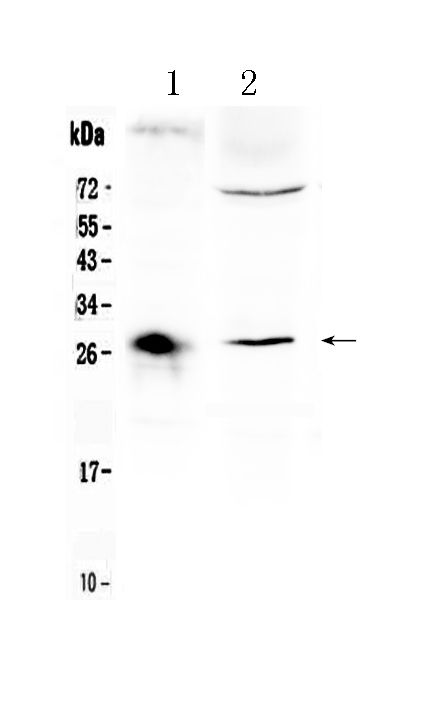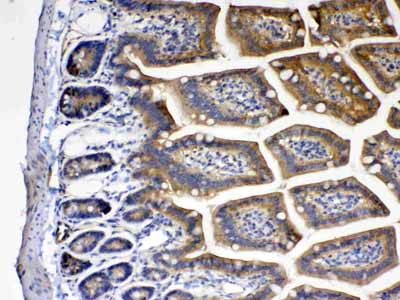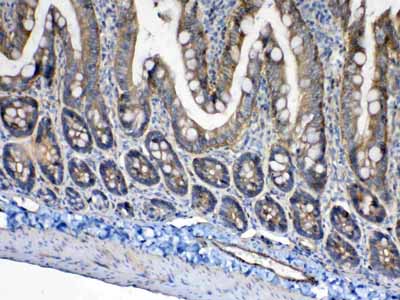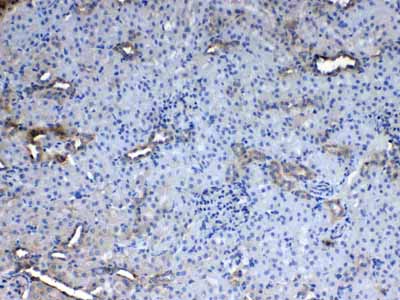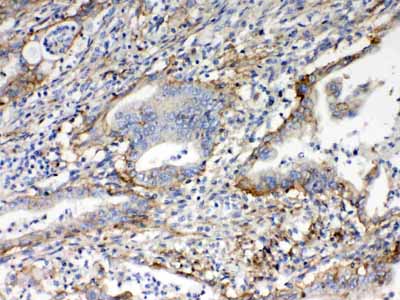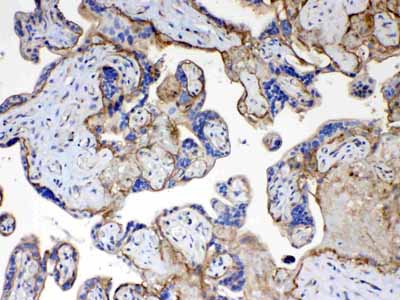Anti-CD151 Picoband Antibody
- SPECIFICATION
- CITATIONS
- PROTOCOLS
- BACKGROUND

Application
| WB, IHC-P |
|---|---|
| Primary Accession | P48509 |
| Host | Rabbit |
| Reactivity | Human, Mouse, Rat |
| Clonality | Polyclonal |
| Format | Lyophilized |
| Description | Rabbit IgG polyclonal antibody for CD151 antigen(CD151) detection. Tested with WB, IHC-P in Human;Mouse;Rat. |
| Reconstitution | Add 0.2ml of distilled water will yield a concentration of 500ug/ml. |
| Gene ID | 977 |
|---|---|
| Other Names | CD151 antigen, GP27, Membrane glycoprotein SFA-1, Platelet-endothelial tetraspan antigen 3, PETA-3, Tetraspanin-24, Tspan-24, CD151, CD151, TSPAN24 |
| Calculated MW | 28295 MW KDa |
| Application Details | Immunohistochemistry(Paraffin-embedded Section), 0.5-1 µg/ml, Human, Mouse, Rat, By Heat Western blot, 0.1-0.5 µg/ml, Human, Rat |
| Subcellular Localization | Membrane; Multi-pass membrane protein. |
| Tissue Specificity | Expressed in a variety of tissues including vascular endothelium and epidermis. Expressed on erythroid cells, with a higher level of expression in erythroid precursors than on mature erythrocytes. . |
| Protein Name | CD151 antigen |
| Contents | Each vial contains 5mg BSA, 0.9mg NaCl, 0.2mg Na2HPO4, 0.05mg NaN3. |
| Immunogen | E.coli-derived human CD151 recombinant protein (Position: A113-A175). Human CD151 shares 88.7% amino acid (aa) sequence identity with both mouse and rat CD151. |
| Purification | Immunogen affinity purified. |
| Cross Reactivity | No cross reactivity with other proteins |
| Storage | At -20˚C for one year. After r˚Constitution, at 4˚C for one month. It˚Can also be aliquotted and stored frozen at -20˚C for a longer time.Avoid repeated freezing and thawing. |
| Name | CD151 |
|---|---|
| Synonyms | TSPAN24 |
| Function | Structural component of specialized membrane microdomains known as tetraspanin-enriched microdomains (TERMs), which act as platforms for receptor clustering and signaling. Plays a role in various cellular and molecular mechanism through its association with both integrin and non-integrin proteins. These interactions facilitate critical cellular functions, including cell-to-cell communication, wound healing, platelet aggregation, trafficking, cell motility, and angiogenesis (PubMed:17045834, PubMed:24723389, PubMed:31488507). Via interaction with JAM-A/F11R and integrin ITGA3:ITGB1, promotes the recruitment of signaling molecules such as RAC1, CDC42 and RhoGTPases to facilitate the polarization of epithelial cells and the reorganization of the actin cytoskeleton, which are critical steps in cell migration process (PubMed:22843693, PubMed:35067832). Regulates the glycosylation pattern of ITGA3:ITGB1 thereby modulating its activity (PubMed:18852263). Plays an essential role in the maintenance of central laminin-binding integrin ITGA6:ITGB4-containing adhesion complexes (PubMed:31488507). Essential for the proper assembly of the glomerular and tubular basement membranes in kidney (PubMed:15265795). Contributes to T-cell activation by modulating integrin signaling leading to activation of downstream targets PTK2 and MAPK1/MAPK3 (PubMed:24723389). |
| Cellular Location | Cell membrane; Multi-pass membrane protein Note=Relocalizes to the immune synapse in T-cells upon activation |
| Tissue Location | Expressed in a variety of tissues including vascular endothelium and epidermis. Expressed on erythroid cells, with a higher level of expression in erythroid precursors than on mature erythrocytes (PubMed:15265795). Acts as a sensitive T-cell activation marker (PubMed:32978478). |

Thousands of laboratories across the world have published research that depended on the performance of antibodies from Abcepta to advance their research. Check out links to articles that cite our products in major peer-reviewed journals, organized by research category.
info@abcepta.com, and receive a free "I Love Antibodies" mug.
Provided below are standard protocols that you may find useful for product applications.
Background
CD151 molecule (Raph blood group), also known as CD151 (Cluster of Differentiation 151), is a human gene. The protein encoded by this gene is a member of the transmembrane 4 superfamily, also known as the tetraspanin family. Most of these members are cell-surface proteins that are characterized by the presence of four hydrophobic domains. The proteins mediate signal transduction events that play a role in the regulation of cell development, activation, growth and motility. This encoded protein is a cell surface glycoprotein that is known to complex with integrins and other transmembrane 4 superfamily proteins. It is involved in cellular processes including cell adhesion and may regulate integrin trafficking and/or function. This protein enhances cell motility, invasion and metastasis of cancer cells. Multiple alternatively spliced transcript variants that encode the same protein have been described for this gene.
If you have used an Abcepta product and would like to share how it has performed, please click on the "Submit Review" button and provide the requested information. Our staff will examine and post your review and contact you if needed.
If you have any additional inquiries please email technical services at tech@abcepta.com.













 Foundational characteristics of cancer include proliferation, angiogenesis, migration, evasion of apoptosis, and cellular immortality. Find key markers for these cellular processes and antibodies to detect them.
Foundational characteristics of cancer include proliferation, angiogenesis, migration, evasion of apoptosis, and cellular immortality. Find key markers for these cellular processes and antibodies to detect them. The SUMOplot™ Analysis Program predicts and scores sumoylation sites in your protein. SUMOylation is a post-translational modification involved in various cellular processes, such as nuclear-cytosolic transport, transcriptional regulation, apoptosis, protein stability, response to stress, and progression through the cell cycle.
The SUMOplot™ Analysis Program predicts and scores sumoylation sites in your protein. SUMOylation is a post-translational modification involved in various cellular processes, such as nuclear-cytosolic transport, transcriptional regulation, apoptosis, protein stability, response to stress, and progression through the cell cycle. The Autophagy Receptor Motif Plotter predicts and scores autophagy receptor binding sites in your protein. Identifying proteins connected to this pathway is critical to understanding the role of autophagy in physiological as well as pathological processes such as development, differentiation, neurodegenerative diseases, stress, infection, and cancer.
The Autophagy Receptor Motif Plotter predicts and scores autophagy receptor binding sites in your protein. Identifying proteins connected to this pathway is critical to understanding the role of autophagy in physiological as well as pathological processes such as development, differentiation, neurodegenerative diseases, stress, infection, and cancer.
